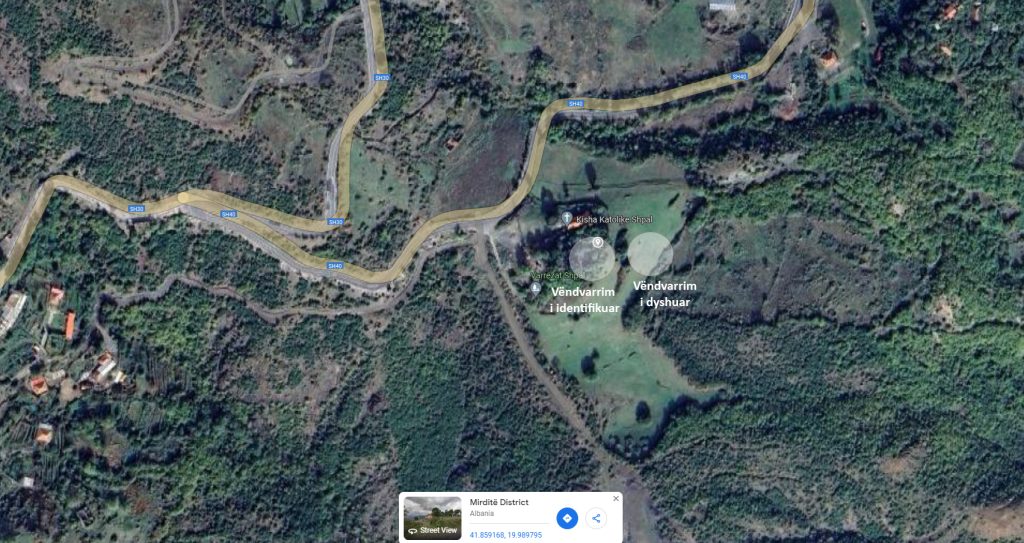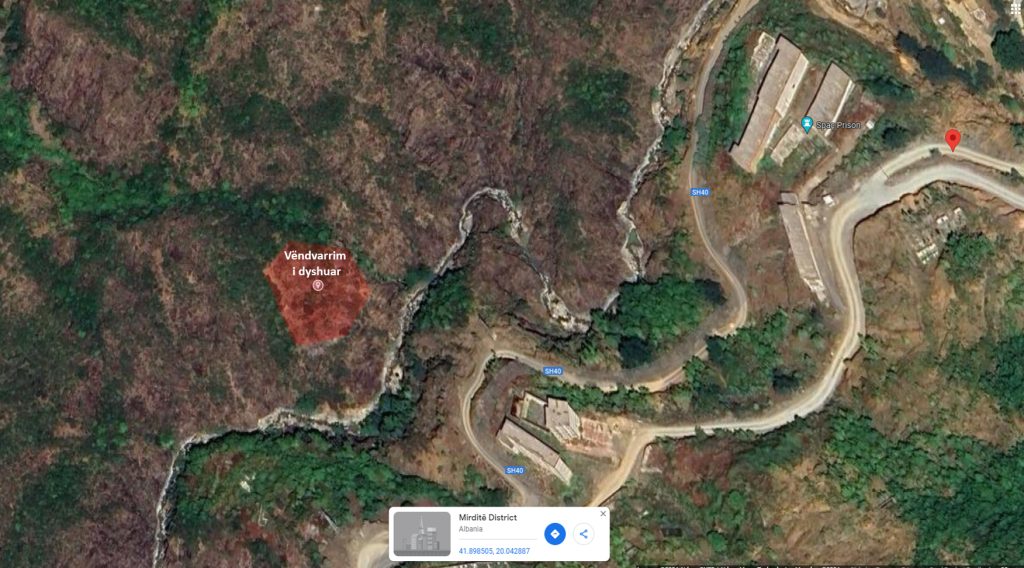The Disappeared of Spaç
Based on Decision no. 374, dated 02.06.2023, for the initiation of an administrative investigation aimed at clarifying the fate, locating, identifying, and recovering the remains of persons who died or went missing while serving their sentences in the Spaç prison camp. From the administrative verifications concerning persons who lost their lives in Spaç and are listed as missing, based on information collected and studied by AIDSSH, the Ministry of Internal Affairs, the General Directorate of Prisons, the General Directorate of Archives, and requests received by AIDSSH to clarify the fate of the missing, a list of persons registered as missing has been compiled. To view the list, click here.
Shpal, Mirditë
The coordinates of the known burial site in Shpal have also been determined according to the State Authority for Geospatial Information.
20 meters from Burial Site 1
Four executed participants of the Spaç Revolt: Skënder Daja, Pal Zefi, Dervish Bejko, and Hajri Pashaj
Burial site of the executed Ahmet Hoxha
The AIDSSH working group conducted investigative visits and found a site believed to contain the remains of the deceased.
Regarding the acts that determined the practices followed for the burial of the bodies of executed, killed, or deceased individuals in camps, prisons, or isolation rooms.
Two regulations are known from the years 1965 and 1977, approved by orders of the Minister of Internal Affairs, numbered 01-68, dated 16.10.1965, and 01-33, dated 24.10.1977, respectively.
In the 1965 regulation, Article 38 explicitly states that ‘the medical inspection reports of the executed and the report kept at the execution site shall remain unaltered for three years from the date of the execution,’ whereas in the 1977 Regulation ‘On Prisoners Who Die or Are Executed,’ it is emphasized that the body must not be handed over to anyone, regardless of whether the prisoner was killed or deceased, with no distinction made between political and non-political prisoners. The only difference is that on the grave of a former political prisoner, only a number should be marked, whereas on the grave of a former non-political prisoner, the full name should be indicated.
This chapter was amended by an instruction from the Minister of Internal Affairs, No. 01-90, dated 08.06.1983, ‘To address certain shortcomings observed in previous practice, and to fulfill the requests of citizens whose relatives—convicted, arrested, or detained—die in re-education camps, prisons, or isolation rooms.’ According to this instruction, the bodies of deceased former non-political prisoners must be returned to their families. Even the mortal remains of those who died years earlier may be returned, provided that at least three years have passed since the time of burial.
However, the bodies are not handed over for those sentenced to death, who are executed because the Presidium of the People’s Assembly did not grant them clemency, for those convicted of crimes against the state, or for those prisoners who, due to their social dangerousness, are treated in a special manner by a specific order of the Minister of Internal Affairs.
The same instruction states that the bodies of those killed while attempting to escape, etc., and who remain unidentified, may also be handed over to medical institutions for their professional activities.
In the known burial sites of those killed and deceased in prisons over the years, up to June 1983, the remains of non-political prisoners who died may also be found.
The rules followed regarding the bodies of those killed and deceased among arrested and convicted persons in the investigative offices, camps, and prisons of the communist regime during 1945–1991 were distributed in the most discreet manner possible, due to the very practices followed, which in most cases constituted crimes in themselves. To illustrate, we cite a paragraph from a 1986 order by the then Minister of Internal Affairs, Simon Stefani, which explicitly states: ‘Point 9. The order of the Minister of Internal Affairs is repealed and must be destroyed according to regulations by the respective authorities and units.’ Thus, in the practices followed, not only were orders repealed by subsequent orders, but many of them were also destroyed.
Question: Who is considered a missing person during the communist period??
Answer:
In Albania, there is no specific law on persons who went missing during the communist regime that defines who is considered a missing person during this period. According to Law No. 114/2020 ‘On some amendments and additions to Law No. 45, dated 30.4.2015, “On the right to access documents of the former State Security of the People’s Socialist Republic of Albania”’, for the first time this definition is provided: A ‘missing person,’ within the scope of this law, is a person who was arrested, imprisoned, abducted, or otherwise deprived of liberty by state agents or by other persons or groups acting with the authorization, support, or approval of the state, followed by denial of the deprivation of liberty or concealment of the fate of the missing person or their location, thereby removing them from legal protection.
Question: Who can report a missing person??
Answer:
1. A family member of the missing person has the right to report the case, according to Law No. 45/2015, as amended. Based on Article 22 of this law, the order of priority is as follows:
a) spouses;
b) children;
c) grandchildren, when the persons mentioned in points ‘a’ and ‘b’ are deceased or declared missing;
ç) parents, when the persons mentioned in points ‘a’, ‘b’, and ‘c’ are deceased or declared missing;
d) siblings, when the persons mentioned in points ‘a’, ‘b’, ‘c’, and ‘ç’ are deceased or declared missing;
dh) The children of brothers and sisters, when the persons listed in the previous categories have died or have been declared missing.
2. The competent state authorities, such as: the State Police, the Authority for the Files, the IPP, according to the scope of their activities as regulated by law or sublegal acts.
Question: Where can the discovery of a missing person be reported??
Answer:
The request can be addressed to:
– The Authority for Information on the Documents of the former State Security. Address: info@autoritetidosjeve.gov.al
– The Institute for the Integration of Former Politically Persecuted Persons.
Address: Rr. “Xhorxh W. Bush”, Vila 2-katëshe nr. 7, Tiranë, e-mail: info@ishperndjekurit.gov.al
It can also be reported to the ICMP Online Research Center, which is an online resource that can be used by the families of missing persons.
Read more in the Guide for the rights of the relatives of persons who disappeared during the communist period.
Based on Law no. 45/2015, as amended in December 2022, the role of the AIDSSH has been defined regarding the process of locating persons who went missing during the communist dictatorship.
In Article 5 of the law, paragraph 1.1 was added, which provides:
"With the aim of establishing the facts and circumstances related to the case, the Authority may:
- a) Collect statements from the parties, witnesses, and experts, ensuring in all cases the confidentiality of individuals who provide information as persons involved in or knowledgeable about the circumstances of the case;
- b) To obtain other documented materials through photographic recording devices or other technical means;
c) To visit and inspect objects or locations related to the case.
Also, in Article 5 of the law, paragraph 1.2 was added, which allows for administrative verifications to clarify the circumstances and facts of specific cases.
“Every person is obliged to cooperate with the Authority when it turns out that they have knowledge of the circumstances of the case, are requested for information as a person involved or knowledgeable about the case, or when they themselves possess information that can assist the Authority in its work. The Authority, in implementing this law, is obliged to guarantee confidentiality for every person who corporates”.
Based on these legal amendments, with the aim of more precisely regulating the methodology and procedures for conducting administrative verifications in accordance with paragraphs 1.1 and 1.2 of Article 5 of Law 45/2015, as amended, the Authority, by Decision no. 625/10, dated 30.03.2023, approved the Guideline “On the Rules and Procedures for Verifying Circumstances and Facts Regarding the Documents of the Former State Security.
Following Decision no. 374, dated 02.06.2023, “On the Approval of the Initiation of the Administrative Investigation Procedure with the Aim of Clarifying the Fate, Identifying, and Recovering the Remains of Political Prisoners Who Died or Went Missing During Their Imprisonment in Spaç Prison,” an administrative investigation has been launched to locate the remains and clarify the fate of prisoners who were executed, killed, or died in prison during their sentence in Spaç Prison.
The administrative investigation has focused on several key actions:
- Inter-institutional communication: Contact with institutions that may hold information about those killed, executed, or deceased in the Spaç prison camp, whose remains were never returned to their families and whose whereabouts were kept secret.
- Document search: Deep research for locating regulations, orders, and directives that established the practices followed regarding the bodies of executed, killed, or deceased prisoners.
- Interviews with former prisoners: Questioning of former prisoners to learn the truths they witnessed during their imprisonment, and to identify the names of the police officers and guards who served in the prison.
- Communication with the families: Contacting the families of missing persons to learn about the efforts they have made to locate the remains of their relatives. Additionally, reaching out to families who have already found the remains of their loved ones to understand the hardships they endured and to gather information about the police officers and prison staff who assisted them in obtaining details for the search.
- Visit to burial sites: Visit to burial sites where remains have been found and collection of data to clarify the procedures followed in cases of executions, killings, deaths, and burials of bodies.
- Communication with former prison staff: Contacting former prison staff to learn what they know or remember about the procedures followed and the locations where prisoners who were killed or died were buried.
- Cooperation with associations of former politically persecuted persons: Mbledhja e të dhënave që këto shoqata kanë ose mund të gjejnë.
- Visits to identified or suspected burial sites: Investigation and collection of evidence at suspected burial sites, such as the Spaç burial site, and the exclusion of other burial sites, such as the alleged Gziqi burial site in Mirditë.
- Cooperation with local authorities: Coordination with local authorities for the protection of suspected burial site areas from alterations and their clearing.
- Meeting with local leaders of the State Police in Mirditë: Informing them about our findings and determinations, transitioning from merely raising awareness to assigning them responsibility for the protection of the area identified as a burial site.
Draft Council of Ministers Decision On the designation of the Responsible Authorities for the location, identification, and recovery of the remains of persons who disappeared or were executed during the communist period in Albania, November 29, 1944 – July 2, 1991, as well as the manner of protection and preservation of identified or suspected burial sites of persons who disappeared during this period, it has been prepared within the framework of the process of identifying and recovering the remains of persons who disappeared or were executed, as well as the manner of preserving the identified or suspected burial sites of persons who disappeared or were executed during the period from November 29, 1944, to July 2, 1991.
The proposed Draft Council of Ministers Decision by AIDSSH aims to define the responsibilities in the process of identifying and recovering the remains of persons who disappeared or were executed, as well as the manner of preserving the identified or suspected burial sites of persons who disappeared or were executed during the period from November 29, 1944, to July 2, 1991.
This draft is the result of inter-institutional cooperation between AIDSSH, the General Prosecutor’s Office, the Ministry of Internal Affairs, ICMP, the State Police Directorate, the Institute of Forensic Medicine, and the Scientific Police Institute. These institutions analyzed legislation, competencies, provided opinions and suggestions, articulated needs, limitations, and concerns, and familiarized themselves with best practices in this field. With the support of the Konrad Adenauer Foundation and the Croatian Ministry of Veterans’ Affairs, and in cooperation with the OSCE, they also studied the Croatian experience in this field through a study visit conducted in September 2022. Video conferences between the inter-institutional roundtable and Croatian counterpart authorities are also noteworthy.
Over the years, the Authority has worked to advance the process of collecting information to clarify the fate of the disappeared, with currently 297 registered requests regarding the clarification of the fate of the disappeared. Additionally, the Authority received a request from the Archdiocese of Shkodër, informing it about the persecution of the Catholic clergy by the communist regime and the execution of 38 Catholic clerics, of whom the remains of 28 remain missing. Another notable request was submitted by the Association of Former Politically Persecuted of Shkodër, containing a list of 315 applications from the families of the disappeared to clarify the fate of their missing relatives.
Based on the amendments to Law no. 45/2015 in December 2022, the Authority also issued three administrative decisions in 2023, which serve to clarify the fate of the disappeared, specifically:
- Decision No. 371, dated 30.05.2023, for initiating the administrative investigation of initial cases;
- Decision No. 374, dated 02.06.2023, for initiating the administrative investigation related to Spaç Prison;
- Decision No. 535, dated 29.08.2023, for initiating the administrative investigation of the disappeared in Shkodër.
Given the high number of requests to clarify the fate of the disappeared, without disregarding requests from families submitted to the Institute of Former Political Persecuted and ICMP, as well as the identification of several suspected burial sites, the approval of this Draft Council of Ministers Decision is essential for carrying out the process of identifying and recovering the remains of persons who disappeared or were executed, and for preserving the identified or suspected burial sites of persons who disappeared or were executed during the period from November 29, 1944, to July 2, 1991.
With the approval of the draft decision, it is envisaged that:
- The identification and recovery of the remains of persons who disappeared or were executed will provide necessary answers to their families and uphold their human rights.
- The preservation of identified or suspected burial sites will aid in further identification of missing persons and in preserving the country’s cultural and historical heritage.
The determination of responsibilities and modalities of cooperation among institutions will contribute to a coordinated and efficient approach to this sensitive issue.
If you are aware of former political prisoners who served their sentence in Spaç prison camp and are reported as missing, click here to download the form. here.




